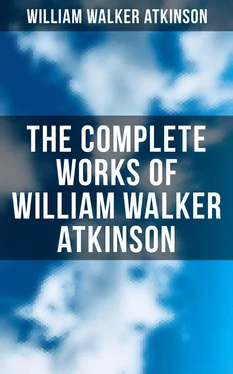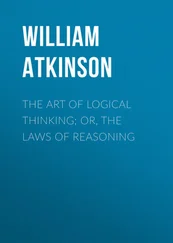Lesson V. "Making-Over" Oneself.
Lesson VI. "Automatic Thinking."
Lesson VII. Inner-Conscious Helpers
Lesson VIII. "Forethought."
Lesson IX. The "Leland Method."
Lesson X. Intuition and Beyond.
Lesson I.
Inner Consciousness.
Table of Content
IT WAS formerly taught in the schools that all of the Mind of an individual was comprised within the limits of ordinary Consciousness, but for many years this old idea has been gradually superceded by more advanced conceptions. Leibnitz was one of the first to advance the newer idea, and to promulgate the doctrine that there were mental energies and activities manifesting on a plane of mind outside of the field of ordinary consciousness. From his time psychologists have taught, more and more forcibly, that much of our mental work is performed outside of the ordinary field of consciousness. And, at the present time, the idea of an “Inner Consciousness” is generally accepted among psychologists.
Lewes says: “The teaching of most modern psychologists is that consciousness forms but a small item in the total of physical processes. Unconscious sensations, ideas and judgments are made to play a great part in their explanations. It is very certain that in every conscious volition—every act that is so characterized—the larger part of it is quite unconscious. It is equally certain that in every perception there are unconscious processes of reproduction and inference—there is a middle distance of subconsciousness, and a background of unconsciousness.” And Sir William Hamilton states: “I do not hesitate to affirm that what we are conscious of is constructed out of what we are not conscious of—that our whole knowledge in fact is made up of the unknown and incognizable. The sphere of our consciousness is only a small circle in the centre of a far wider sphere of action and passion, of which we are only conscious through its effects.” And Taine has said in connection with the same thought: “Mental events imperceptible to consciousness are far more numerous than the others, and of the world which makes up our being we only perceive the highest points—the lightedup peaks of a continent whose lower levels remain in the shade. Beneath ordinary sensations are their components, that is to say, the elementary sensations, which must be combined into groups to reach our consiousness. Outside a little luminous circle lies a great large ring of twilight, and beyond this an indefinite night; but the events of this twilight and this night are as real as those within the luminous circle.” To this, Maudsley adds his testimony, as follows: “Examine closely and without bias the ordinary mental operations of life, and you will surely discover that consciousness has not onetenth part of the function therein which it is commonly assumed to have. In every conscious state there are at work conscious, subconscious and infraconscious energies, the last as indispensable as the first.”
It is now known that “InnerConscious” ideas, impressions and thoughts play a most important part in the thoughtworld of every individual. Beyond every outerconscious action there may be found a vast innerconscious background. It is held that of our entire mental processes, less than ten per cent are performed in the field of outerconsciousness. As a well known writer has so well expressed it: “Our self is greater than we know; it has peaks above and lowlands below the plateau of our conscious experience.” Prof. Elmer Gates has forcibly put it: “At least ninety per cent of our mental life is subconscious. If you will analyze your mental operations you will find that conscious thinking is never a continuous line of consciousness, but a series of conscious data with great intervals of subconsciousness. We sit and try to solve a problem and fail. We walk around, try again and fail. Suddenly an idea dawns that leads to a solution of the problem. The subconscious processes were at work. We do not volitionally create our own thinking. It takes place in us. We are more or less passive recipients. We cannot change the nature of a thought, or of a truth, but we can, as it were, guide the ship by a moving of the helm.”
But, perhaps, the most beautiful expression of this underlying truth, is that of Sir Oliver Lodge, who says in his consideration of the subject: “Imagine an iceberg glorying in its crisp solidity, and sparkling pinnacles, resenting attention paid to its submerged self, or supporting region, or to the saline liquid out of which it arose, and into which in due course it will some day return. Or, reversing the metaphor, we may liken our present state to that of the hull of a ship submerged in a dim ocean among strange monsters, propelled in a blind manner through space; proud perhaps of accumulating many barnacles of decoration; only recognizing our destination by bumping against the dockwall; and with no cognizance of the deck and cabins above us, or the spars and sails—no thought of the sextant, and the compass, and the captain—no perception of the lookout on the mast— of the distant horizon. With no vision of objects far ahead— dangers to be avoided—destinations to be reached—other ships to be spoken to by means other than by bodily contact—a region of sunshine and cloud, of space, or perception, and of intelligence utterly inaccessible below the waterline.”
Dr. Schofield has cleverly and beautifully illustrated the idea in the following words: “Our conscious mind, as compared with the unconscious mind, has been likened to the visible spectrum of the sun’s rays, as compared to the invisible part which stretches indefinitely on either side. We know now that the chief part of heat comes from the ultrared rays that show no light; and the main part of the chemical changes in the vegetable world are the results of the ultraviolet rays at the other end of the spectrum, which are equally invisible to the eye, and are recognized only by their potent effects. Indeed as these invisible rays extend indefinitely on both sides of the visible spectrum, so we may say that the mind includes not only the visible or conscious part, and what we have termed the subconscious, that which lies below the red line, but also the supraconscious mind that lies at the other end—all those regions of higher soul and spirit life, of which we are only at times vaguely conscious, but which always exist, and link us on to eternal verities, on the one side, as surely as the subconscious mind links us to the body on the other.”
The late Frederic W. H. Myers, after years of careful study and research along the lines of the “outofconsciousness” states, formulated a hypothesis of a “secondary self,” or as he called it a “Subliminal Self,” which “self” he held possessed certain powers which it exercised in a measure independent of the ordinary conscious “self.” Perhaps the best explanation of his hypothesis has been stated by Mr. Myers, himself, in his book entitled “Human Personality,” in which he states: “The idea of a threshold of consciousness—of a level above which sensation or thought must rise before it can enter into our conscious life—is a simple and familiar one. The word Subliminal—meaning ‘beneath the threshold’—has already been used to define those sensations which are too feeble to be individually recognized. I propose to extend the meaning of the term, so as to make it cover all that takes place beneath the ordinary threshold, or say, if preferred, the ordinary margin of consciousness—not only those faint stimulations, whose very faintness must keep them submerged, but much else which psychology as yet scarcely recognizes; sensations, thoughts, emotions, which may be strong definite, and independent, but which, by the original constitution of our being, seldom merge into that Supraliminal current of consciousness which we habitually identify with ourselves. Perceiving that these submerged thoughts and emotions possess the characteristics which we associate with conscious life, I feel bound to speak of a Subliminal, or Ultramarginal, Consciousness—a consciousness which we shall see, for instance, uttering or writing sentences quite as complex and coherent as the supraliminal consciousness could make them. Perceiving further that this conscious life beneath the threshold or beyond the margin seems to be no discontinuous or intermittent thing; that not only are these isolated subliminal processes comparable with isolated supraliminal processes (as when a problem is solved by some unknown procedure in a dream) but that there also is a continuous subliminal chain of memory (or more chains than one) involving just that kind of individual and persistent revival of old impressions and response to new ones, which we commonly call a Self—I find it permissible to speak of subliminal Selves, or more briefly a subliminal self. I do not indeed by using this term assume that there are two correlative and parallel selves existing always within each of us. Rather I mean by the Subliminal Self that part of the Self which is commonly subliminal; and I conceive that there may be—not only many coöperations between these quasiindependent trains of thought—but also upheavals and alternations of personality of many kinds, so that what was once below the surface may for a time, or permanently, rise above it. And I conceive also that no Self of which we can here have cognizance is in reality more than a fragment of a larger self—revealed in a fashion at once shifting and limited through an organism not so framed as to afford it full manifestation.”
Читать дальше












